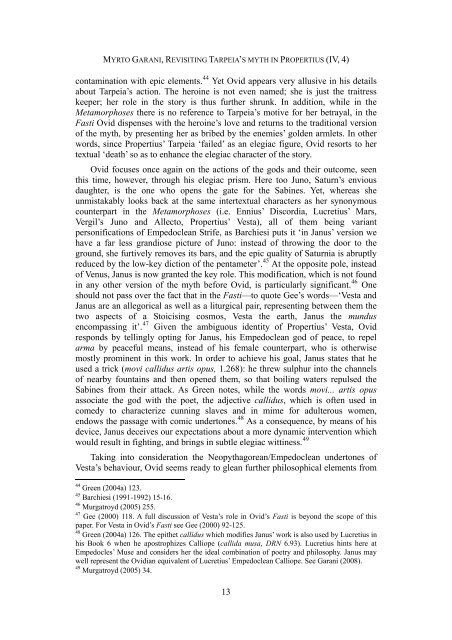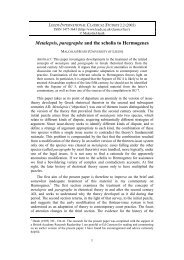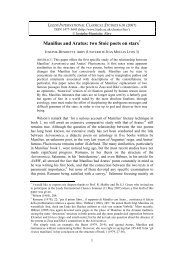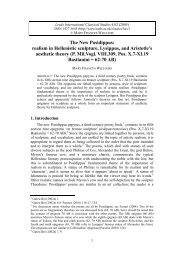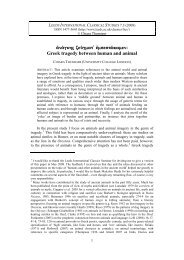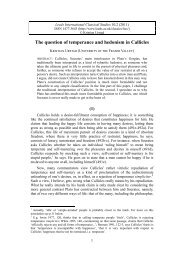Revisiting Tarpeia's myth in Propertius (IV, 4) - Leeds International ...
Revisiting Tarpeia's myth in Propertius (IV, 4) - Leeds International ...
Revisiting Tarpeia's myth in Propertius (IV, 4) - Leeds International ...
Create successful ePaper yourself
Turn your PDF publications into a flip-book with our unique Google optimized e-Paper software.
MYRTO GARANI, REVISITING TARPEIA’S MYTH IN PROPERTIUS (<strong>IV</strong>, 4)<br />
contam<strong>in</strong>ation with epic elements. 44 Yet Ovid appears very allusive <strong>in</strong> his details<br />
about Tarpeia’s action. The hero<strong>in</strong>e is not even named; she is just the traitress<br />
keeper; her role <strong>in</strong> the story is thus further shrunk. In addition, while <strong>in</strong> the<br />
Metamorphoses there is no reference to Tarpeia’s motive for her betrayal, <strong>in</strong> the<br />
Fasti Ovid dispenses with the hero<strong>in</strong>e’s love and returns to the traditional version<br />
of the <strong>myth</strong>, by present<strong>in</strong>g her as bribed by the enemies’ golden armlets. In other<br />
words, s<strong>in</strong>ce <strong>Propertius</strong>’ Tarpeia ‘failed’ as an elegiac figure, Ovid resorts to her<br />
textual ‘death’ so as to enhance the elegiac character of the story.<br />
Ovid focuses once aga<strong>in</strong> on the actions of the gods and their outcome, seen<br />
this time, however, through his elegiac prism. Here too Juno, Saturn’s envious<br />
daughter, is the one who opens the gate for the Sab<strong>in</strong>es. Yet, whereas she<br />
unmistakably looks back at the same <strong>in</strong>tertextual characters as her synonymous<br />
counterpart <strong>in</strong> the Metamorphoses (i.e. Ennius’ Discordia, Lucretius’ Mars,<br />
Vergil’s Juno and Allecto, <strong>Propertius</strong>’ Vesta), all of them be<strong>in</strong>g variant<br />
personifications of Empedoclean Strife, as Barchiesi puts it ‘<strong>in</strong> Janus’ version we<br />
have a far less grandiose picture of Juno: <strong>in</strong>stead of throw<strong>in</strong>g the door to the<br />
ground, she furtively removes its bars, and the epic quality of Saturnia is abruptly<br />
reduced by the low-key diction of the pentameter’. 45 At the opposite pole, <strong>in</strong>stead<br />
of Venus, Janus is now granted the key role. This modification, which is not found<br />
<strong>in</strong> any other version of the <strong>myth</strong> before Ovid, is particularly significant. 46 One<br />
should not pass over the fact that <strong>in</strong> the Fasti—to quote Gee’s words—‘Vesta and<br />
Janus are an allegorical as well as a liturgical pair, represent<strong>in</strong>g between them the<br />
two aspects of a Stoicis<strong>in</strong>g cosmos, Vesta the earth, Janus the mundus<br />
encompass<strong>in</strong>g it’. 47 Given the ambiguous identity of <strong>Propertius</strong>’ Vesta, Ovid<br />
responds by tell<strong>in</strong>gly opt<strong>in</strong>g for Janus, his Empedoclean god of peace, to repel<br />
arma by peaceful means, <strong>in</strong>stead of his female counterpart, who is otherwise<br />
mostly prom<strong>in</strong>ent <strong>in</strong> this work. In order to achieve his goal, Janus states that he<br />
used a trick (movi callidus artis opus, 1.268): he threw sulphur <strong>in</strong>to the channels<br />
of nearby founta<strong>in</strong>s and then opened them, so that boil<strong>in</strong>g waters repulsed the<br />
Sab<strong>in</strong>es from their attack. As Green notes, while the words movi... artis opus<br />
associate the god with the poet, the adjective callidus, which is often used <strong>in</strong><br />
comedy to characterize cunn<strong>in</strong>g slaves and <strong>in</strong> mime for adulterous women,<br />
endows the passage with comic undertones. 48 As a consequence, by means of his<br />
device, Janus deceives our expectations about a more dynamic <strong>in</strong>tervention which<br />
would result <strong>in</strong> fight<strong>in</strong>g, and br<strong>in</strong>gs <strong>in</strong> subtle elegiac witt<strong>in</strong>ess. 49<br />
Tak<strong>in</strong>g <strong>in</strong>to consideration the Neopythagorean/Empedoclean undertones of<br />
Vesta’s behaviour, Ovid seems ready to glean further philosophical elements from<br />
44 Green (2004a) 123.<br />
45 Barchiesi (1991-1992) 15-16.<br />
46 Murgatroyd (2005) 255.<br />
47 Gee (2000) 118. A full discussion of Vesta’s role <strong>in</strong> Ovid’s Fasti is beyond the scope of this<br />
paper. For Vesta <strong>in</strong> Ovid’s Fasti see Gee (2000) 92-125.<br />
48 Green (2004a) 126. The epithet callidus which modifies Janus’ work is also used by Lucretius <strong>in</strong><br />
his Book 6 when he apostrophizes Calliope (callida musa, DRN 6.93). Lucretius h<strong>in</strong>ts here at<br />
Empedocles’ Muse and considers her the ideal comb<strong>in</strong>ation of poetry and philosophy. Janus may<br />
well represent the Ovidian equivalent of Lucretius’ Empedoclean Calliope. See Garani (2008).<br />
49 Murgatroyd (2005) 34.<br />
13


